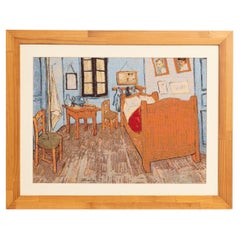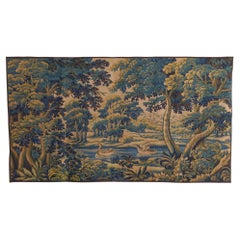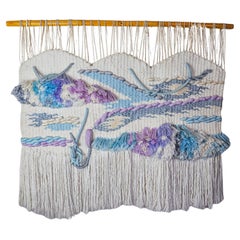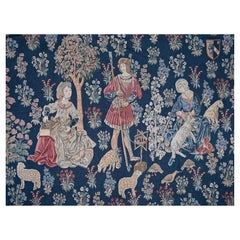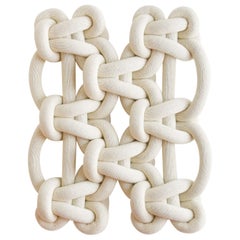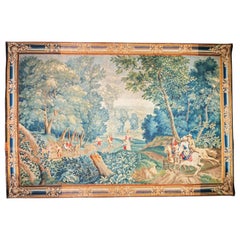European Tapestries
to
712
1,328
794
1,930
223
22
Height
to
Width
to
220
178
98
85
45
28
24
19
16
16
13
11
10
8
6
2
2
438
426
1,066
245
126
598
265
16
3
28
23
25
73
96
125
35
14
2,058
1,514
441
396
175
2,175
1,386
1,237
532
418
2,175
2,013
2,082
124
59
24
21
20
Place of Origin: European
Vintage Framed Tapestry of "The Bedroom" after Vincent van Gogh
By Vincent van Gogh
Located in Barcelona, ES
This framed tapestry, made in France by an unknown artist, beautifully represents Vincent van Gogh's iconic painting "The Bedroom." It is in original condition, with minor wear consi...
Category
1960s Mid-Century Modern Vintage European Tapestries
Materials
Textile
$1,867 Sale Price
55% Off
Vintage French Verdure Tapestry by Les Tapisseries D’Halluin - 2 Available
Located in Chicago, IL
Sold and priced individually.
This lush vintage tapestry from Les Tapisseries D’Halluin—one of France’s historic weaving houses—is a striking verdure scene rendered in painterly sha...
Category
20th Century Aubusson European Tapestries
Materials
Fabric
Textured macrame wall hanging, Spain, 1970s
Located in BARCELONA, ES
Superb macramé wall tapestry made in Spain in the 1970s. Large format. Handmade tapestry composed of different textures and materials creating unique patterns and reliefs. All the ro...
Category
1970s Hollywood Regency Vintage European Tapestries
Materials
Wool, Cotton
French Tapestry, Genuine Jacquard in Medieval Style - H 131 x W 190 cm - N 1439
By Royal Manufacture of Aubusson, Aubusson Manufacture
Located in Paris, FR
Located a stone's throw from the Eiffel Tower in Paris, we are a French family business
specializing in the purchase, sale, expertise, cleaning, restoration and conservation of
tapes...
Category
19th Century Medieval Antique European Tapestries
Materials
Wool
32" x 39" Knotted Fiber Art Sculpture, Macrame Wall Hanging, KNITKNOT – nubes
By Tamar Samplonius
Located in WARMENHUIZEN, NL
This macrame / knitted tapestry is MADE TO ORDER. The time needed to create this design is 11-12 weeks.
Because this fiber art tapestry is made to order, please allow some slight v...
Category
2010s Modern European Tapestries
Materials
Wool, Alpaca, Yarn, Foam
17th Century Fine Flemish Tapestry, Silk & Wool, Green, Blue, Red, Battle Scene
Located in Port Washington, NY
The tapestry shown here is a magnificent example of 17th-century European artistry, likely influenced by the grand tradition of tapestry weaving that flourished in France and Flander...
Category
Mid-17th Century French Provincial Antique European Tapestries
Materials
Wool, Silk
$79,199 Sale Price
20% Off
Spring Levee, Jean-Michel Lartigaud - French modern Aubusson Tapestry - No. 1513
By Aubusson Manufacture
Located in Paris, FR
This magnificent modern tapestry from the Aubusson Manufacture, having benefited from a deep cleaning and a careful verification and doubled by experts in our artisanal Workshop. It ...
Category
20th Century Modern European Tapestries
Materials
Wool
SALE 60s Rya Rug Danish Modern Etruscan Horses & Riders Tapestry Wall Hanging
By Ege Rya, Ege Denmark
Located in St.Petersburg, FL
60s Vintage Ege Rya Rug Wool Danish Modern Cubist Etruscan Horses & Riders Textile Art Wall Hanging
Extraordinary and very rare 1960's Mid Century...
Category
Mid-20th Century Mid-Century Modern European Tapestries
Materials
Wool
$1,020 Sale Price
20% Off
Late 19th Century French Figurative Tapestry
Located in New York, NY
Late 19th century French Tapestry
Measures: 7'10" x 8'6".
Category
Late 19th Century Vienna Secession Antique European Tapestries
Materials
Wool
French Tapestry Signed By The Aubusson Factory, Circa 1860 - 278lx200h - No 1474
By Aubusson Manufacture
Located in Paris, FR
French Tapestry Signed By The Aubusson Factory, Circa 1860 - 278lx200h - No. 1474
This tapestry is a fine example of the 19th century Aubusson verdure. This type of tapestry is char...
Category
1860s Aubusson Antique European Tapestries
Materials
Wool, Silk
17th c. French Aubusson Tapestry Fragment
By Isaac Moillon
Located in Wichita, KS
French Baroque tapestry fragment depicting a scene from Greek mythology, Poseidon and Amphitrite, circa 1690. Attributed to Isaac Moillon, Pari...
Category
17th Century Baroque Antique European Tapestries
Materials
Tapestry
Antique Handcrafted needlepoint depicting a classical romanticized Orientalist
Located in Port Washington, NY
This needlepoint is a handcrafted piece depicting a classical or romanticized Orientalist scene, possibly inspired by Ancient Rome, Persia, or the Ottoman Empire.
The woman lounging ...
Category
Early 20th Century European Tapestries
Materials
Wool, Silk
1880's Antique French Wool and Silk Aubusson Tapestry
Located in Dallas, TX
76928 Late 19th-Century Antique French Aubusson Verdure Tapestry, Landscape Scene Wall Hanging. This hand-woven silk and wool late 19th-century antique French Aubusson verdure tapestry depicts a landscape scene of the French countryside. Displaying dense foliage, greenery, fauna and flowers, this verdure tapestry portrays a tranquil setting. The floral scroll and bird border seamlessly blends into the pictorial scene without taking away from the majestic style. An outer border composed of a zigzag chevron add interest and a pop of color. Rendered in variegated shades of brown, ecru, taupe, pale green, slate blue, red, pink, lavender, beige and charcoal. The hues of brown range from chocolate brown to lighter shades of brown reflecting a fallow color to sand. Other colors range from ecru (greyish-pale yellow or a light greyish-yellowish brown) to old gold (yellow color that varies from light olive or olive brown) and hues of olive and sage green. With its commitment to tradition and heart full of whimsy, this antique Aubusson wall hanging...
Category
Late 19th Century Louis XVI Antique European Tapestries
Materials
Wool, Silk
Vintage Venetian Renaissance Style Brocade Panels, 100% Silk, Italy, C.1970's
Located in Chatham, ON
Rare and grand Venetian Renaissance style silk brocade panels (two panels per length - total of three sets available as one continuous length or sold separately) - opulent woven patt...
Category
Mid-20th Century Renaissance European Tapestries
Materials
Silk
$2,520 Sale Price / set
30% Off
772 -Tapestry Robert Debieve of the 20th Century
By Royal Manufacture of Aubusson
Located in Paris, FR
"Sub-Marine" modern tapestry of the 20th century realised by Robert Debieve, in perfect condition of conservation.
Negotiable price and free delivery.
Dimension: 157 cm x 113 cm.
Category
1970s Mid-Century Modern Vintage European Tapestries
Materials
Wool
Tapestry Jean Lurcat "Blue Coral" Atlerie Suzanne Goubely-gatien N° 1416
By Jean Lurçat, Suzanne Goubely Atelier
Located in Paris, FR
A stone's throw from the Eiffel Tower We are a family business specializing in the purchase, sale and
expertise of old, modern and contemporary tapestries, rugs, kilims and textiles....
Category
1960s Aubusson Vintage European Tapestries
Materials
Wool
19th Century Aubusson Tapestry Portiere/ Door surround
By Aubusson Manufacture
Located in Chipping Campden, GB
19th Century French Aubusson tapestry Portiere or door surround.
Woven with floral foliage on a cream ground, bordered by trompe l'oeil swags and tassels. Hessian backed.
Note: Our...
Category
Late 19th Century Aubusson Antique European Tapestries
Materials
Tapestry
Antique Late 17th Century Square Flemish Verdure Landscape Tapestry
Located in New York, NY
This is a gorgeous antique late 17th century Flemish verdure landscape tapestry depicting a beautiful and rich summer scene of a countryside with lush trees and vegetation, with two ...
Category
17th Century Baroque Antique European Tapestries
Materials
Tapestry, Wool
Pretty Vintage Aubusson Style Jacquard Tapestry
Located in Saint Ouen, FR
Beautiful vintage French Aubusson style tapestry with a nice design of the nature with trees, vegetation inside the wood, and with a river. and with beautiful colours, entirely woven...
Category
Mid-20th Century Aubusson European Tapestries
Materials
Wool, Cotton
$1,536 Sale Price
20% Off
Handwoven Ikat Natural Indigo & Plant Dyed Block Framed Artwork
By Pamela Print
Located in Chelmsford, GB
This striking contemporary piece of Handwoven textile art is one of a collection of one-off plant-dyed pieces designed and produced by British Weaver Pamela Print
This piece is dyed...
Category
2010s European Tapestries
Materials
Wool
Vintage French Wall Tapestry from the Paris Colonial Exhibition of 1931
Located in COLMAR, FR
A fabulous, vintage souvenir from the Paris Colonial Exhibition in 1931. This rare wall tapestry has been well preserved by a French owner for many years and is therefore in very goo...
Category
1930s Vintage European Tapestries
Materials
Textile
$1,340 Sale Price
20% Off
Victor Vasarely, Hand Signed Original Tapestry
By Victor Vasarely
Located in Geneve, CH
Victor Vasarely (1906-1997).
Panderlak,
circa 1983
Measures: 120 x 72 cm
Hand signed and numbered on the back, edition of 320.
Victor Vasarely, whose original name was Gyözö ...
Category
1980s Modern Vintage European Tapestries
Materials
Wool
$14,229 / item
Pair Antique 18th Century Flemish Tapestries, Circa 1780.
Located in New Orleans, LA
Pair Antique 18th Century Flemish Tapestries, Circa 1780.
Category
18th Century Antique European Tapestries
Materials
Tapestry
Antique French Aubusson Tapestry Rare Wool & Silk Renaissance 4x5 1890 132x155cm
Located in New York, NY
Antique French Aubusson Tapestry Rare Wool & Silk Renaissance c.1890 4'4" x 5'1" 132 cm x 155cm
"This is an outstanding antique French Aubusson tapestry- This piece incorporates ...
Category
1890s Antique European Tapestries
Materials
Wool
Important Anni Albers style Bauhaus or Black Mountain Period Hand Weaving
By Bauhaus, Anni Albers
Located in Sharon, CT
A period hand woven horizontal rectangles in two yellows and off white in a strict 'implied verticals' geometric Bauhaus or Black Mountain Design. Approximately 26 x 25.75 x 3/8".
Category
Early 20th Century Bauhaus European Tapestries
Materials
Cotton
Antique French Forest Scene Tapestry, circa 1880 4'6 x 10'
Located in New York, NY
Antique French Forest scene tapestry, circa 1880, 4'6 x 10'. An antique French fine hand-loomed tapestry, circa 1880. A forest scene, with trees and foliage surrounded by a floral bo...
Category
19th Century Antique European Tapestries
Materials
Wool
Impressive Crewelwork Tree of Life Panel
By Aubusson Manufacture
Located in Canterbury, GB
A large impressive Crewelwork Hanging /Bed Cover
Embroidered in wool upon a cream linen ground
Depicting an Indienne / Palampore design, Tree of Life
Featuring mythical animals and ...
Category
Mid-20th Century Jacobean European Tapestries
Materials
Wool, Cotton
Bobyrug’s Nice Vintage Jaquar Tapestry with Lion II – Darius Tapestry Design
Located in Saint Ouen, FR
"Discover Lion II – Darius Tapestry –
A stunning vintage Belgian tapestry showcasing a captivating design inspired by the rich history of Pers...
Category
Late 20th Century Aubusson European Tapestries
Materials
Wool, Cotton
$2,371 Sale Price
20% Off
Nice French Aubusson Style Jacquard Tapestry
Located in Saint Ouen, FR
"Exquisite French tapestry from the mid-20th century, featuring a beautiful design, showing a gallant scene with young people playing hide and seek game, with nice colours in hues of...
Category
Mid-20th Century Aubusson European Tapestries
Materials
Wool, Cotton
$1,707 Sale Price
20% Off
Vintage Green “kreis” Verner Panton Textile 3'10" x 3'10"
By Verner Panton
Located in New York, NY
Vintage Green “Kreis” Verner Panton Textile, Origin: Denmark, Mid 20th Century
Category
Mid-20th Century Scandinavian Modern European Tapestries
Materials
Other
The 12 Tribes of Israel, Tapestry by Salvador Dalí Notarial Certificate -N° 1468
By Salvador Dalí
Located in Paris, FR
Artist: Salvador Dalí
Era: 20th century
Style: Design 50s-60s
Condition: Perfect condition
Material: Tapestry
Width: 130 cm
Height: 180 cm
Depth: 1 cm
The 12 Tribes of Israel, Salvador Dalí – Tapestry...
Category
20th Century Mid-Century Modern European Tapestries
Materials
Wool
18th Century Crewelwork Tree of Life Wall Hanging
By Aubusson Manufacture
Located in Canterbury, GB
A beautiful Crewelwork Panel
English and dating from 18th century
The Oatmeal linen ground exquisitely embroidered with a delicate Tree of Life design
Worked in fine wools. W...
Category
18th Century Jacobean Antique European Tapestries
Materials
Wool, Linen, Silk
Wall tapestry artist unknown
Located in grand Lancy, CH
Wall tapestry artist unknown
Category
1970s Vintage European Tapestries
Materials
Tapestry
Pretty large vintage French Aubusson style Jacquard Tapestry « dog on standby»
Located in Saint Ouen, FR
"Discover the timeless elegance of this exquisite vintage French tapestry featuring a reproducing of the paintings of the famous French painter "Jean Baptiste Oudry (1686-1755)". Dog...
Category
Mid-20th Century Aubusson European Tapestries
Materials
Wool, Cotton, Acrylic
$2,191 Sale Price
20% Off
Beautiful Antique French Fine Needlepoint Tapestry
Located in Saint Ouen, FR
Very beautiful late 19th century needlepoint tapestry with beautiful design of a scene of an elderly lady teaching a young girl to sew, and with beautiful natural colors, entirely an...
Category
Late 19th Century Aubusson Antique European Tapestries
Materials
Wool
$1,195 Sale Price
20% Off
Mid-Century Modern Tapestry by Jean Picart le Doux, 'Hommage a Paul Eluard'
By Jean Picart Le Doux
Located in London, GB
This is a stunning tapestry by the well-known tapestry maker Jean Picart le Doux. It is signed on the bottom right hand side. The tapestry is named 'Homage a Paul Eluard...
Category
1950s Mid-Century Modern Vintage European Tapestries
Materials
Wool
“Heliotrope” Tapestry Signed by Hervé Lelong
By Hervé Lelong
Located in Beirut, LB
Tapestry in “pure laine vierge” signed by Hervé Lelong
Entitled “Heliotrope”
Depicting a colorful flowers scene in the style of J.Lurcat
Hand woven wool
Category
1960s Mid-Century Modern Vintage European Tapestries
Materials
Wool
Antique French Tapestry with Dutch Pictorial Scene, 03'02 x 04'03
By Jean-Baptiste Oudry
Located in Dallas, TX
78542 Rare Antique French Tapestry with Dutch Pictorial Scene, 03'02 x 04'03. Step into a world of pastoral elegance and old-world charm with this early 20th century French handwoven...
Category
Early 20th Century Aubusson European Tapestries
Materials
Wool
Antique Flemish Tapestry Verdure Bird Wool & Silk 115cmx168cm Green 4x6 C.1880
Located in New York, NY
Antique Flemish Tapestry Verdure Flamingo Bird Wool & Silk 115cmx168cm Green 4x6 C.1880
115cm x 168cm
"This is a magnificent Antique Flemish Tapestry in Wool & Silk. It has a sce...
Category
1880s Rococo Antique European Tapestries
Materials
Wool, Silk
Large Vintage Wall Tapestry, French, Needlepoint, Display Panel, Medieval Taste
Located in Hele, Devon, GB
This is a large vintage wall tapestry. A French, quality needlepoint display panel depicting a Medieval tournament scene, dating to the late 20th...
Category
Late 20th Century European Tapestries
Materials
Textile
Mid-Century French Textile Wall Hanging Design by Robert Debiève
By Roger Debievres
Located in Antwerp, BE
This striking mid-century French wall hanging is a printed textile artwork designed by renowned French artist Robert Debiève. Known for his vibrant, playful compositions, Debiève’s...
Category
Mid-20th Century Mid-Century Modern European Tapestries
Materials
Fabric
$2,561 Sale Price
41% Off
French Art Deco Tapestry
Located in New York, NY
French Art Deco tapestry
France, circa 1970s
Handwoven
Signed: Bleynie.
Category
Late 20th Century Art Deco European Tapestries
Materials
Wool
$35,000
Bobyrug’s Wonderful Vintage French Hand Printed Tapestry Vendanges Design
Located in Saint Ouen, FR
Discover the elegance of this mid-century French hand-printed, numbered tapestry featuring the exquisite design of the renowned medieval museum tapestry, "Les Vendanges" (grape harve...
Category
Mid-20th Century Medieval European Tapestries
Materials
Cotton
$1,764 Sale Price
20% Off
Starfish, Jean Picart Le Doux - French Aubusson Tapestry, Maison Berthaut - 1543
By Aubusson Manufacture, Jean Picart Le Doux
Located in Paris, FR
Artist: Charles Marcel Jean Picart Le Doux
Era: 20th century
Style: 1950s-1960s design
Condition: Perfect condition
Material: Wool
Width: 200 cm
Height: 150 cm
Depth: 0.5 cm
In keep...
Category
20th Century Modern European Tapestries
Materials
Wool
Holly, Elie Grekoff - French Aubusson Tapestry, Edition E/A - 183lx115h - N 1511
By Aubusson Manufacture, Elie Grekoff
Located in Paris, FR
This magnificent Tapestry has benefited from a deep cleaning and a careful check by our experts in our artisanal Workshop. It is now ready to adorn your interior.
Artist: Elie Greko...
Category
20th Century Modern European Tapestries
Materials
Wool
18th Century French Bizarre Needlepoint Panel
By Aubusson Manufacture
Located in Canterbury, GB
The early 18th century (circa 1720) needlework panel worked in wool and silk threads, with a central Female figure playing a musical instrument amongst fruiting and blossoming trees,...
Category
Mid-18th Century Belle Époque Antique European Tapestries
Materials
Silk, Wood
Wall Tapestry “La Vague a l’Ame” By Jacques Brachet, France 1974
Located in Hellouw, NL
Jacques Brachet is a French artist born in 1928 in Vitry-sur-Seine. A municipality about four kilometers south of Paris. He received his education at t...
Category
1970s Mid-Century Modern Vintage European Tapestries
Materials
Fabric
$18,498 Sale Price
20% Off
French 19th Century Tapisserie de Verdure
Located in Baton Rouge, LA
This 19th century French Tapisserie de Verdure, circa 1850s, is exquisite. It is wool and cotton, and hangs on a metal tapestry rod with rings. The s...
Category
19th Century Other Antique European Tapestries
Materials
Tapestry
pretty vintage French Aubusson style Jacquard tapestry
Located in Saint Ouen, FR
"Experience the timeless elegance of this exquisite French Aubusson style tapestry, capturing the essence of a gallant celebration amidst the countryside. Woven on a Jacquard loom wi...
Category
Late 20th Century Aubusson European Tapestries
Materials
Wool, Cotton
$758 Sale Price
20% Off
18th Century French Felletin Chinoiserie Mythological Tapestry w/ Trees & Satyrs
Located in New York, NY
An 18th century French Felletin chinoiserie mythological tapestry, size 11'6"H x 17'9"W.
This grand mythological tapestry depicts a mythological forest scene, with various satyrs and other mythological figures reveling in Dionysian fashion in the confines of the woodland setting. Finely detailed, with nimble articulation of figures and form, the piece also incorporates chinoiserie motifs, with stylized trees and bushes that have Oriental styling. The lower right corner of the primary field features both the town mark and weaver's mark, as well as the French symbol of the fleur de lis. The tapestry is enclosed within an elaborate outer border, featuring pendant...
Category
18th Century Antique European Tapestries
Materials
Wool, Silk
$199,996 Sale Price
20% Off
Pretty vintage French Aubusson style hand printed tapestry medieval design
Located in Saint Ouen, FR
"Experience the timeless elegance of this exquisite French Aubusson style tapestry, capturing the essence of an 15th century Flanders tapestry with a design titled « La battue » (the...
Category
Mid-20th Century Aubusson European Tapestries
Materials
Wool, Cotton
$1,878 Sale Price
20% Off
1870 Antique French Tapestry Wool & Silk Tapestry Beige Handmade Tapestry
Located in New York, NY
Amazing Rare Antique French Tapestry Fine Wool & Silk
Beige
5'2" x 8"
158cm x249cm
Circa 1870
"This is a very fine Authentic Antique French Tapestry in Wool & Silk....
Category
1870s Antique European Tapestries
Materials
Silk
17th Century French New Testament Religious Tapestry, Marriage of Mary & Joseph
Located in New York, NY
A French religious tapestry from Paris, circa 17th century, size 11' H x 11' W. This magnificent handwoven wool and silk wall hanging envisions the marriage of the New Testament figures, Mary and Joseph, with the High Priest flanked by Mary and Joseph at center and a dove above them, and with the central figures attended by a noblewoman and a group of men, and with a mother and child seated in the right foreground.
The central scene is enclosed within a border that is characterized by upper and lower central cartouches, supported by putti. It contains a star above, and the armorial of Pierre Guischard below. Six additional cartouches containing the symbols of the Evangelists run through the rest of the border, interspersed with fruiting and flowering elements, decorative swags, and birds.
Pierre Guischard (1614-1701) was doctor of Theology of the Holy Faculty of Paris and Great Master of the College of Navarre in Paris, Advisor, Chaplain and King Louis 14th...
Category
17th Century Antique European Tapestries
Materials
Wool, Silk
$67,996 Sale Price
20% Off
Wall Tapestry – Geometric Composition from the 70s
Located in Barcelona, ES
Wall Tapestry – Geometric Composition from the 70s
This wall tapestry, crafted in France around 1970 by an unknown artist, is an impressive textile work of art that stands out for i...
Category
1970s Mid-Century Modern Vintage European Tapestries
Materials
Textile
$3,498 / item
Early Georgian Needlework Picture
Located in Greenwich, CT
An George I English needlework picture depicting musicians, maidens, dogs and ducks in the grounds of an estate with detailed renderings of flora an...
Category
1750s George II Antique European Tapestries
Materials
Textile
$2,900 Sale Price
57% Off
Pretty vintage French Aubusson style Jacquard Tapestry
Located in Saint Ouen, FR
"Discover the timeless elegance of this exquisite vintage French tapestry featuring a galant scene.
Elevate your space with the charm of this beautifully crafted and woven tapestry,...
Category
Mid-20th Century Aubusson European Tapestries
Materials
Wool, Cotton, Acrylic
$1,897 Sale Price
20% Off
19th Century French Tapestry of a Forest Hunting Scene "The Hunts of Maximilian"
Located in Barrington, IL
This exquisite 19th-century French tapestry, woven using a Jacquard loom, is a faithful reproduction of Panel II from the renowned Renaissance tapestry series, The Hunts of Maximilia...
Category
Late 19th Century Antique European Tapestries
Materials
Wool, Cotton
Bobyrug’s Nice French Aubusson Style Jacquard Tapestry
Located in Saint Ouen, FR
"Exquisite French tapestry from the mid-20th century, featuring a beautiful design and nice colours, woven at Jules Pansu workshops in jacquard loom by wool and cotton. »
✨✨✨
"Exper...
Category
Mid-20th Century Aubusson European Tapestries
Materials
Wool, Cotton
$1,479 Sale Price
20% Off
18th Century Italian Framed Embroidered Panel
Located in Los Angeles, CA
This antique Italian embroidered panel is a finely handwoven work in wool, showcasing exceptional craftsmanship and decorative richness. Likely dating from the 18th century, the vert...
Category
18th Century Renaissance Antique European Tapestries
Materials
Metallic Thread
Pretty Vintage French Hand Printed Tapestry Titled "the danse"
Located in Saint Ouen, FR
Nice 20th century French tapestry, in style of Aubusson tapestries, with a design of a medieval museum tapestry called « La Danse » ( The Danse) and beautiful colors, hand printed on...
Category
Mid-20th Century Aubusson European Tapestries
Materials
Cotton
$1,447 Sale Price
20% Off
Recently Viewed
View AllMore Ways To Browse
Campana Mirror
Cantonese Plate
Carlin Furniture
Carlton Ball Pottery
Cartridge Box
Carved Jade Panel
Carved Wooden Statues Of Saints
Caste Designs
Celadon Lotus Vase
Champagne Pewter
Cherry China Cabinet
Cherry Highboy Dresser
Cherub Casket
Chest 32 X 19 X 32
Childs Chair Rush Seat
Chinese Blue And White Foo Dogs
Chinese Bronze Wine Vessel
Chinese Cocktail Cabinet
